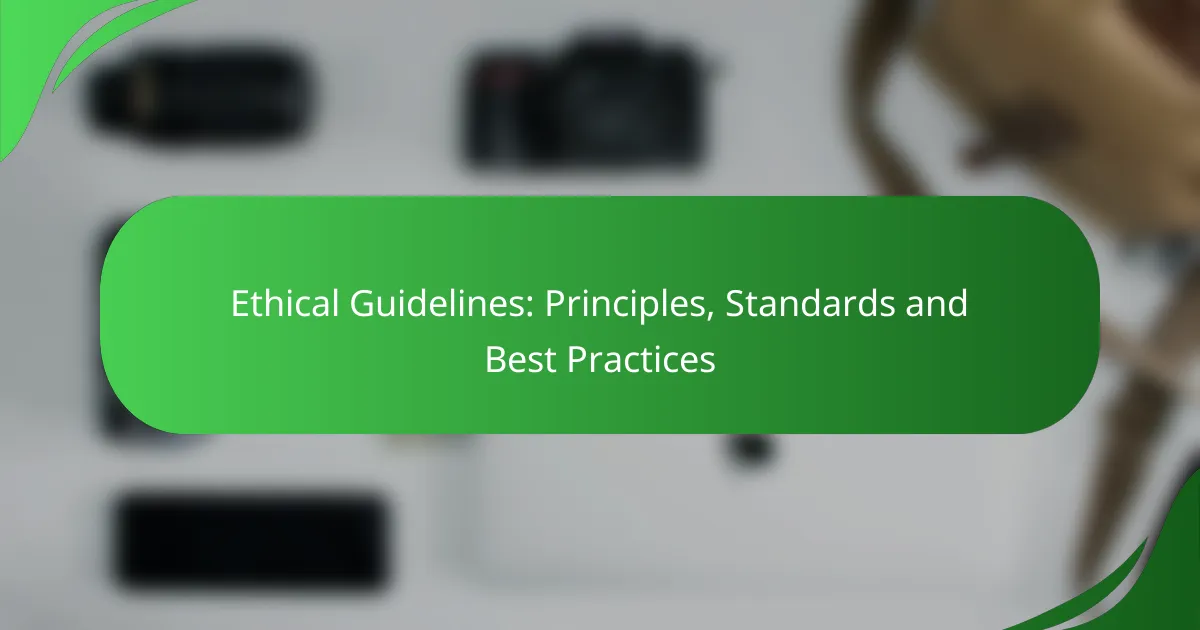Ethical considerations surrounding youth athletes are crucial for ensuring their rights, safety, and overall well-being. This includes implementing safeguarding policies, protecting them from exploitation, and maintaining a supportive environment during competitions. Additionally, best practices for interviewing young athletes emphasize comfort and respect, which are essential for gathering accurate information while prioritizing their emotional health.
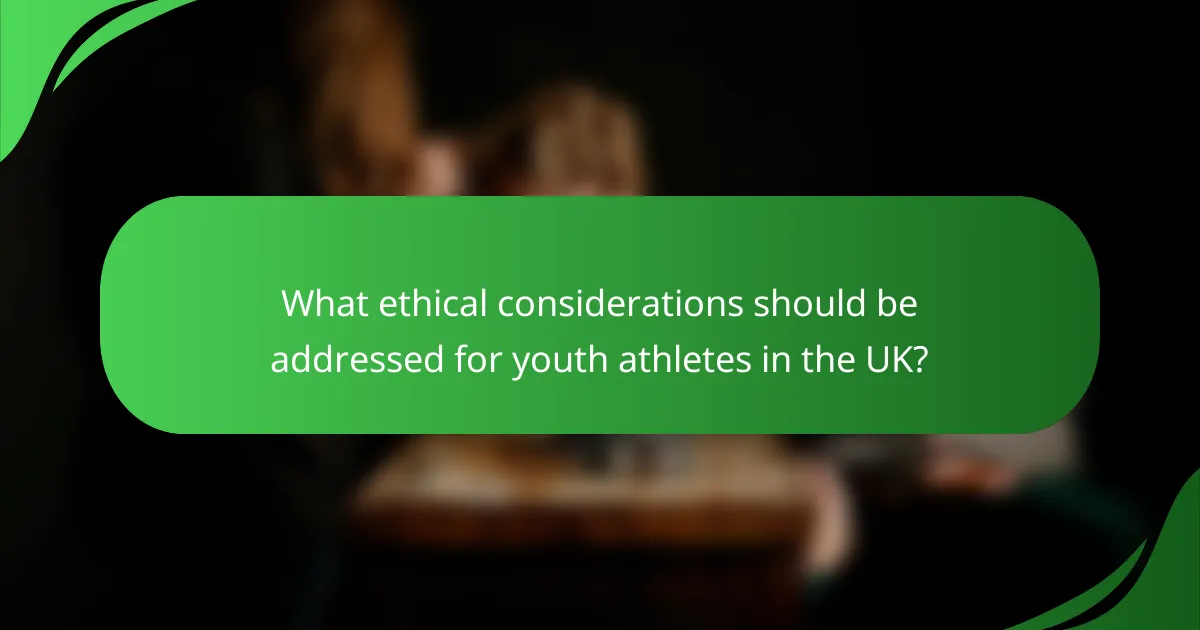
What ethical considerations should be addressed for youth athletes in the UK?
Ethical considerations for youth athletes in the UK focus on their rights, safety, and well-being. Key areas include informed consent, protection from exploitation, and the implementation of safeguarding policies to ensure a safe sporting environment.
Informed consent processes
Informed consent is crucial when involving youth athletes in sports activities. It requires clear communication about the risks and benefits of participation, ensuring that both athletes and their guardians understand what is involved.
Consent should be obtained in writing, detailing the nature of the sport, any potential hazards, and the athlete’s right to withdraw at any time. This process helps to empower young athletes and fosters a culture of transparency.
Protection from exploitation
Protection from exploitation involves safeguarding youth athletes from any form of abuse or manipulation, whether physical, emotional, or financial. Coaches and organizations must be vigilant in recognizing and preventing situations where young athletes may be taken advantage of.
Clear guidelines and training for adults involved in youth sports are essential. This includes educating coaches on appropriate behavior and establishing reporting mechanisms for any concerns about exploitation.
Safeguarding policies
Safeguarding policies are designed to protect youth athletes by outlining procedures for ensuring their safety and well-being. These policies should be comprehensive, covering areas such as recruitment, training, and reporting of incidents.
Organizations should regularly review and update safeguarding measures to reflect best practices and legal requirements. Engaging parents and guardians in these discussions can enhance the effectiveness of safeguarding policies and create a supportive environment for young athletes.
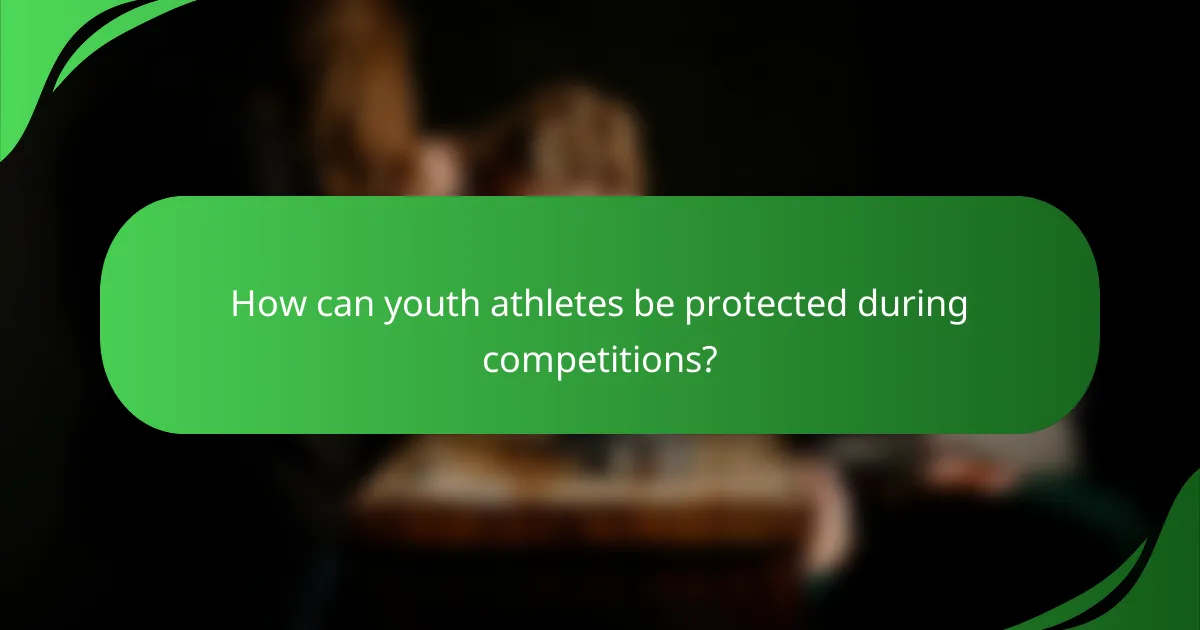
How can youth athletes be protected during competitions?
Protecting youth athletes during competitions involves implementing safety measures, monitoring their well-being, and ensuring supportive coaching. These strategies help create a safe environment that prioritizes the health and safety of young competitors.
Implementation of safety protocols
Safety protocols are essential for minimizing risks during competitions. These may include pre-event medical screenings, proper equipment checks, and adherence to age-appropriate rules and regulations. For example, organizations often require protective gear like helmets and pads in contact sports.
Establishing clear emergency procedures is also vital. This includes having trained medical personnel on-site and ensuring that all participants are aware of evacuation routes and emergency contacts. Regular drills can help familiarize everyone with these protocols.
Monitoring of physical and mental health
Continuous monitoring of both physical and mental health is crucial for youth athletes. Coaches and medical staff should regularly assess athletes for signs of fatigue, injury, or psychological stress. This can involve routine check-ins and assessments before and after competitions.
Implementing a feedback system where athletes can express their concerns can also enhance monitoring efforts. Encouraging open communication helps identify issues early, allowing for timely interventions to protect the athlete’s well-being.
Role of coaches in athlete welfare
Coaches play a pivotal role in ensuring the welfare of youth athletes. They should prioritize the athletes’ health over winning, fostering a supportive environment that encourages personal growth and resilience. This includes promoting fair play and respect among competitors.
Coaches should also be educated on recognizing signs of distress or burnout in their athletes. Providing resources for mental health support and encouraging a balanced approach to training can significantly enhance an athlete’s experience and safety during competitions.
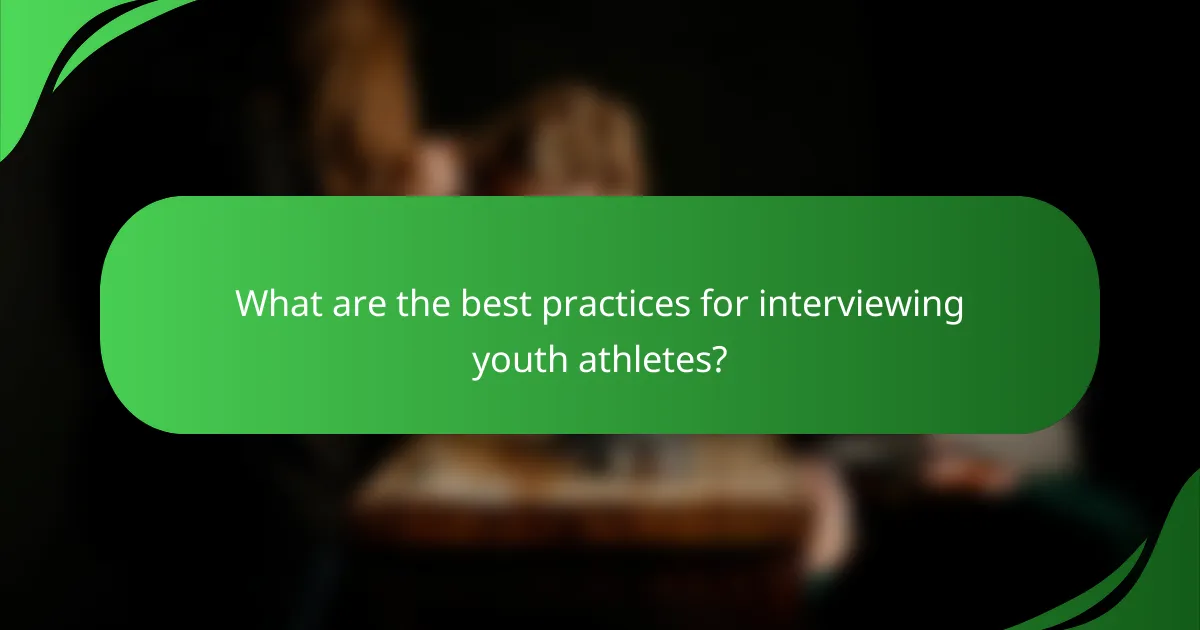
What are the best practices for interviewing youth athletes?
Best practices for interviewing youth athletes focus on ensuring comfort, clarity, and respect. These practices help gather accurate information while protecting the emotional and psychological well-being of young participants.
Age-appropriate questioning techniques
When interviewing youth athletes, use age-appropriate questioning techniques that match their developmental stage. For younger children, ask simple, direct questions that require straightforward answers, while older teens may engage better with open-ended questions that encourage elaboration.
Consider the athlete’s experience level as well. For example, novice athletes might need more guidance on how to express their thoughts, while seasoned competitors may be ready to discuss strategies and performance insights. Tailor your approach accordingly.
Creating a safe interview environment
Creating a safe interview environment is crucial for youth athletes to feel comfortable sharing their thoughts. Choose a quiet, private space free from distractions, where the athlete feels secure and respected. Ensure that the setting is familiar, such as a training facility or a community center.
Additionally, establish rapport by introducing yourself and explaining the purpose of the interview. Make it clear that their participation is voluntary and that they can skip questions or stop the interview at any time if they feel uncomfortable.
Training for interviewers on sensitivity
Training interviewers on sensitivity is essential to effectively engage with youth athletes. Interviewers should understand the unique challenges young athletes face, including pressure from parents, coaches, and peers. This awareness fosters empathy and helps interviewers ask questions that are respectful and considerate.
Provide interviewers with resources on child development, active listening techniques, and appropriate language to use. Role-playing scenarios can also be beneficial, allowing interviewers to practice handling sensitive topics and responding to the athlete’s emotional cues appropriately.
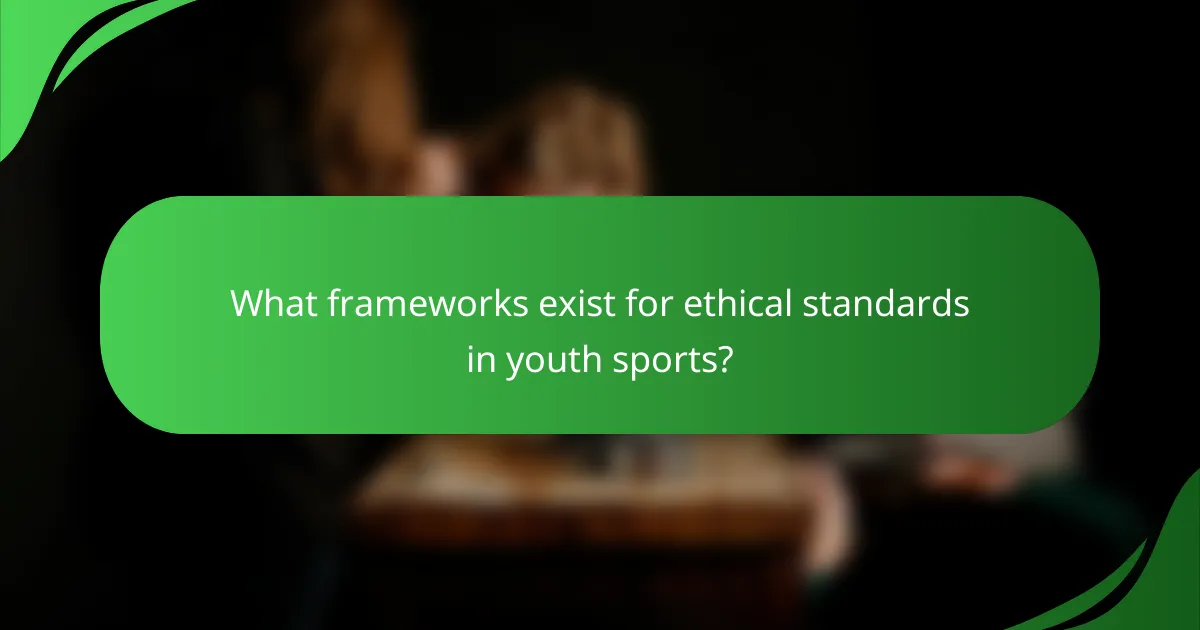
What frameworks exist for ethical standards in youth sports?
Various frameworks guide ethical standards in youth sports, focusing on the protection and well-being of young athletes. These frameworks aim to ensure fair play, safety, and respect within sporting environments.
UK Sports Council guidelines
The UK Sports Council provides comprehensive guidelines that emphasize safeguarding young athletes. These guidelines include principles such as ensuring the welfare of children, promoting inclusion, and encouraging positive behavior among coaches and participants.
Key aspects of the UK Sports Council guidelines involve regular training for coaches on child protection and creating a safe environment for all participants. Organizations are encouraged to implement clear reporting procedures for any concerns regarding athlete safety.
National governing body policies
National governing bodies (NGBs) establish specific policies tailored to their sports, which align with broader ethical standards. These policies typically address issues such as athlete welfare, anti-bullying measures, and the importance of parental involvement.
For example, many NGBs require background checks for coaches and volunteers working with youth athletes. They also provide resources for education on the rights of young athletes, ensuring they understand their role in a safe sporting environment.
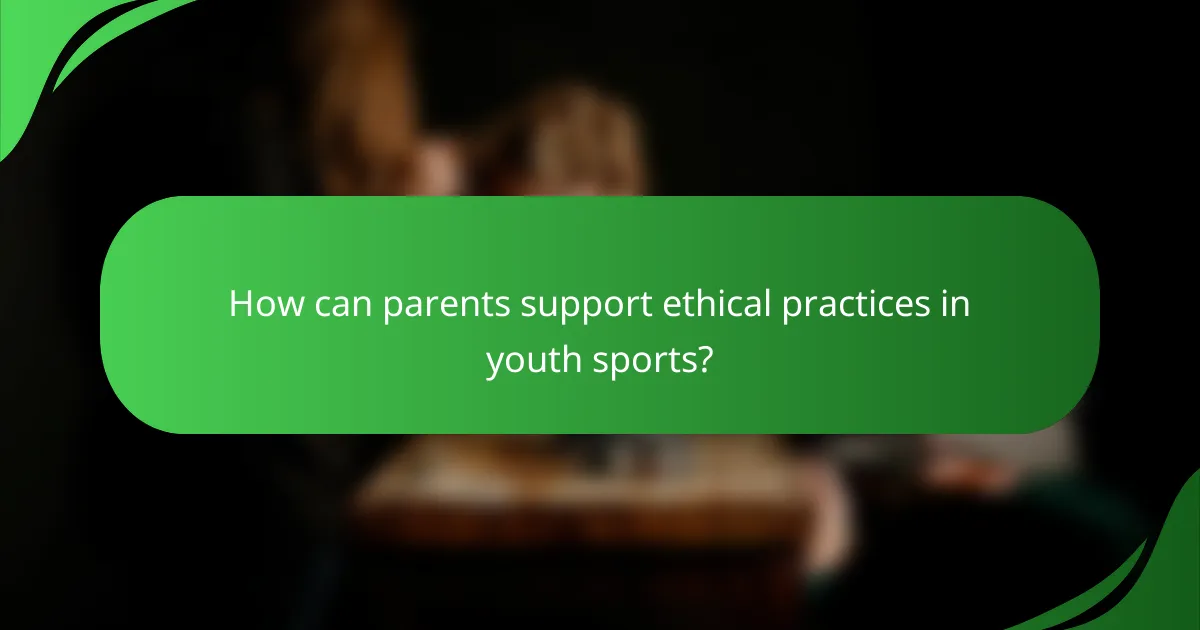
How can parents support ethical practices in youth sports?
Parents can play a crucial role in fostering ethical practices in youth sports by promoting fairness, respect, and safety. They should actively engage with coaches and organizations to ensure that the environment is supportive and that the rights of young athletes are upheld.
Encouraging open communication
Open communication between parents, coaches, and athletes is essential for creating a positive sports environment. Parents should encourage their children to express their feelings about their experiences in sports, whether they are positive or negative. Regular discussions can help identify any issues early, allowing for timely resolutions.
Additionally, parents should feel comfortable discussing their concerns with coaches. This dialogue can lead to better understanding and alignment on goals, expectations, and the overall experience of the young athlete.
Understanding athlete rights
It is important for parents to be aware of the rights of young athletes, which include the right to participate in a safe environment and to receive fair treatment. Familiarizing themselves with local regulations and guidelines, such as those set by national sports organizations, can empower parents to advocate effectively for their children.
Parents should also educate their children about their rights in sports, including the right to voice concerns and the right to withdraw from situations that feel unsafe or uncomfortable. This knowledge can help young athletes feel more confident and supported in their sporting endeavors.
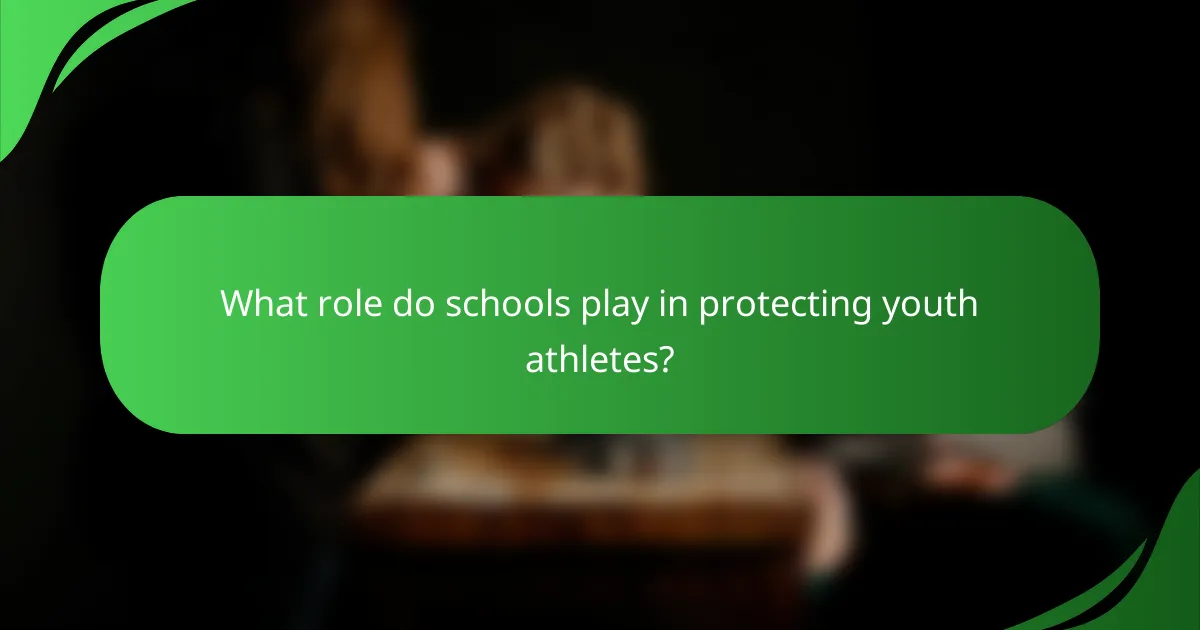
What role do schools play in protecting youth athletes?
Schools play a crucial role in safeguarding youth athletes by implementing policies and practices that prioritize their health, safety, and well-being. This includes creating an environment that promotes ethical behavior, education on sportsmanship, and adherence to safety regulations.
Integration of sports education in curriculum
Integrating sports education into the school curriculum helps students understand the importance of physical activity, teamwork, and fair play. Schools can offer courses that cover topics such as nutrition, injury prevention, and the psychological aspects of sports, which contribute to the overall development of young athletes.
Additionally, schools should emphasize the ethical considerations of sports, teaching students about respect, integrity, and the consequences of unsportsmanlike conduct. This foundational knowledge can help shape responsible athletes who are aware of their actions both on and off the field.
Collaboration with sports organizations
Collaboration with local sports organizations enhances the protective measures schools can offer to youth athletes. By partnering with these organizations, schools can access resources such as trained coaches, medical professionals, and safety programs that ensure athletes receive proper guidance and care.
Moreover, these partnerships can facilitate workshops and training sessions for coaches and staff, focusing on best practices in athlete protection, injury management, and ethical coaching standards. This collective effort helps create a safer and more supportive environment for young athletes to thrive.



